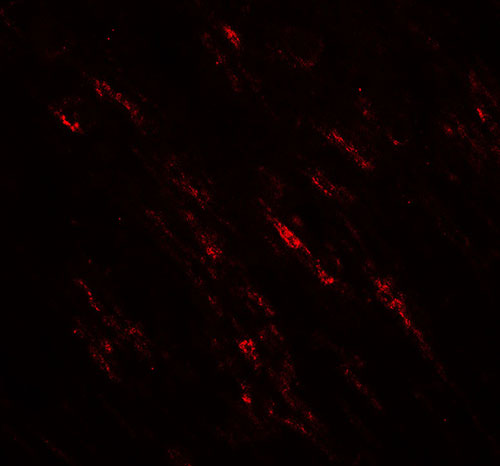POU2F3 Antibody
- SPECIFICATION
- CITATIONS
- PROTOCOLS
- BACKGROUND

Application
| WB, IHC-P, IF, E |
|---|---|
| Primary Accession | Q9UKI9 |
| Other Accession | NP_001231611, 347658964 |
| Reactivity | Human, Mouse, Rat |
| Host | Rabbit |
| Clonality | Polyclonal |
| Isotype | IgG |
| Calculated MW | Predicted: 48 kDa Observed: 55 kDa |
| Application Notes | POU2F3 antibody can be used for detection of POU2F3 by Western blot at 1 - 2 µg/ml. Antibody can also be used for Immunohistochemistry at 5 µg/mL. For Immunoflorescence start at 20 µg/mL. |
| Gene ID | 25833 |
|---|---|
| Target/Specificity | POU2F3; POU2F3 antibody is human, mouse and rat reactive. At least two isoforms are known to exist. This antibody will recognize both isoforms. POU2F3 antibody is predicted to not cross-react with other members of the POU domain class 2 family. |
| Reconstitution & Storage | POU2F3 antibody can be stored at 4℃ for three months and -20℃, stable for up to one year. |
| Precautions | POU2F3 Antibody is for research use only and not for use in diagnostic or therapeutic procedures. |
| Name | POU2F3 (HGNC:19864) |
|---|---|
| Synonyms | OTF11, PLA1 |
| Function | Transcription factor that binds to the octamer motif (5'- ATTTGCAT-3') and regulates cell type-specific differentiation pathways. Involved in the regulation of keratinocytes differentiation (PubMed:11329378). The POU2F3-POU2AF2/POU2AF3 complex drives the expression of tuft-cell-specific genes, a rare chemosensory cells that coordinate immune and neural functions within mucosal epithelial tissues (PubMed:35576971). |
| Cellular Location | Nucleus {ECO:0000250|UniProtKB:P31362}. |
| Tissue Location | Specifically expressed in epidermis and cultured keratinocytes. |

Thousands of laboratories across the world have published research that depended on the performance of antibodies from Abcepta to advance their research. Check out links to articles that cite our products in major peer-reviewed journals, organized by research category.
info@abcepta.com, and receive a free "I Love Antibodies" mug.
Provided below are standard protocols that you may find useful for product applications.
Background
POU2F3, also known as Epoc-1, is a member of a family of POU domain family of transcription factors (1). POU2F3 is expressed primarily in the epidermis and plays a critical role in keratinocyte proliferation and differentiation (1,2). It is a crucial transcription factor that is required for the development of sweet, umami, and bitter, but not sour taste receptor cells (3). POU2F3 is also a candidate tumor suppressor protein, and aberrant promoter methylation of this gene may play a role in cervical cancer (4).
References
Yukawa K, Yasui T, Yamamoto A, et al. Epoc-1: a POU-domain gene expressed in murine epidermal basal cells and thymic stromal cells. Gene 1993; 133:163-9.
Cabral A, Fischer DF, Vermeij WP, et al. Distinct functional interactions of human Skn-1 isoforms with Ese-1 during keratinocyte terminal differentiation. J. Biol. Chem. 2003; 278:17792-9.
Matsumoto I, Ohmoto M, Narukawa M, et al. Skn-1a/Pou2f3 specifies taste receptor cell lineage. Nat. Neurosci. 2011; 14:685-7.
Zhang Z, Huettner PC, Nguyen L, et al. Aberrant promoter methylation and silencing of the POU2F3 gene in cervical cancer. Oncogene 2006; 25:5436-45.
If you have used an Abcepta product and would like to share how it has performed, please click on the "Submit Review" button and provide the requested information. Our staff will examine and post your review and contact you if needed.
If you have any additional inquiries please email technical services at tech@abcepta.com.













 Foundational characteristics of cancer include proliferation, angiogenesis, migration, evasion of apoptosis, and cellular immortality. Find key markers for these cellular processes and antibodies to detect them.
Foundational characteristics of cancer include proliferation, angiogenesis, migration, evasion of apoptosis, and cellular immortality. Find key markers for these cellular processes and antibodies to detect them. The SUMOplot™ Analysis Program predicts and scores sumoylation sites in your protein. SUMOylation is a post-translational modification involved in various cellular processes, such as nuclear-cytosolic transport, transcriptional regulation, apoptosis, protein stability, response to stress, and progression through the cell cycle.
The SUMOplot™ Analysis Program predicts and scores sumoylation sites in your protein. SUMOylation is a post-translational modification involved in various cellular processes, such as nuclear-cytosolic transport, transcriptional regulation, apoptosis, protein stability, response to stress, and progression through the cell cycle. The Autophagy Receptor Motif Plotter predicts and scores autophagy receptor binding sites in your protein. Identifying proteins connected to this pathway is critical to understanding the role of autophagy in physiological as well as pathological processes such as development, differentiation, neurodegenerative diseases, stress, infection, and cancer.
The Autophagy Receptor Motif Plotter predicts and scores autophagy receptor binding sites in your protein. Identifying proteins connected to this pathway is critical to understanding the role of autophagy in physiological as well as pathological processes such as development, differentiation, neurodegenerative diseases, stress, infection, and cancer.




